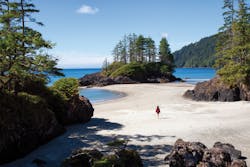I grew up on an island off the west coast of Canada, three blocks from the beach, nestled among the evergreen-covered sand dunes. Thousands of years ago, the ocean and the wind built the huge sand dunes and, as the ocean receded, a temperate rainforest took over. All around us, walking trails wound through the trees, up and over the dunes, and down to the shoreline.
Once we reached the beach, we would admire the large windows and sunny patios of the beachfront properties, almost always bounded in by retaining walls to protect the soil under the decks and lawns from being washed away by the eroding force of winter storms. We didn’t have to look far to see the consequences of a lack of protection; on a sandy cliff above one of our favorite beaches, a portion of ragged wire-and-wood fence sagged precariously over the edge. I can recall the anxiety I felt as a child at the idea that the earth around me was slowly being washed away—how long until my island was gone completely?
I mention all of this just to say I was familiar with the importance of stabilizing soil before I began working on Erosion Control magazine. Since those childhood walks on the beach, I’ve learned how important the work of controlling erosion truly is, not just in stabilizing shorelines but in preventing deadly mudslides, keeping sediment from waterbodies, and managing vegetation growth. Now, as the new editor of Erosion Control, I look forward to continuing to share and highlight the why and the how of controlling sediment and erosion.
In “The Hills Are Alive With... Mustard”, we look at efforts to stabilize and revegetate after the 2018 Woolsey Fire, which burned 88% of the National Park Service’s holdings in and around the Santa Monica Mountains. The recovery plan includes emergency stabilization measures, such as redirecting sediment and debris, and long-term revegetation strategies.
In “Defending the Shoreline”, we look at how several areas are dealing with threats such as sea level rise, coastal erosion, post-fire debris flows, or, in some cases, a combination of all three.
In “Sediment Solutions”, we look at how three very different sites—a cattle farm-turned-nature-preserve, a mixed-use development beside a sustainable citrus farm, and a construction company—are controlling sediment.
Controlling and reducing erosion and sedimentation is about much more than just protecting beautiful beaches. It’s about protecting human life and property after a devastating fire and in coastal communities, keeping sediment and pollutants out of our water systems, and managing vegetation. Erosion Control magazine has always promoted the value of this work, and it will continue to do so. What do you see as the most important part of this industry? Send your comments to [email protected].
Rachel Sim | Editor
As the editor of Stormwater magazine from June 2019 to December 2020, Rachel Sim created and curated quality content addressing the challenges faced by surface water and erosion control professionals, focusing on cutting-edge technology and the latest environmental research.






